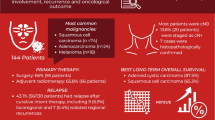Abstract
Sinonasal malignancies are said to be a highly heterogeneous group of cancers, accounting for less than 1 % of all cancers and less than 3 % of all upper aerodigestive tract tumors. Originating from any histologic components of the sinonasal cavity, the histopathology of these tumors is diverse. Accordingly, treatment options vary, surgery being the mainstay in most of them. Recurrence rates differs with each histological type of tumor, dependent on various factors. In this article, we have tried to identify the prevalent characteristics of sinonasal malignancies and to outline the prognostic factors affecting the outcome. It is a retrospective study design with a total number of 102 patients. Patients diagnosed with sinonasal malignancies were included and any patient previously operated outside our institute or having received prior radiation or chemotherapy were excluded. The patients were selected over a period of 10 years, from 2000 to 2010. Data was analyzed using SPSS 17. Majority of the sinonasal tumors were squamous cell carcinomas involving the maxillary sinus. Locoregional recurrence was found to be more frequent in patients with positive neck nodes on final histopathology. Sinonasal malignancies are mostly squamous cell in variety and recurrence of these rare entities is dependent on the histological variety and the presence of positive neck nodes.



Similar content being viewed by others
References
Turner JH, Reh DD (2012) Incidence and survival in patients with sinonasal cancer: a historical analysis of population-based data. Head Neck 34:877–885
Blanch JL, Ruiz AM, Alos L, Coderch JT, Sprekelsen MB (2004) Treatment Of 125 sinonasal tumors: prognostic factors, outcome, and follow-up. Otolaryngol Head Neck Surg 131:973–976
American Joint Committee on Cancer (2003) AJCC Cancer Staging Manual, 6th edn. Springer, New York
Mattavelli CG, Pizzi N, Podrecca S, Valentini V (2000) Malignant maxillary tumors involving the pterygo-maxillary and infratemporal fossae: a series of 65 patients and a comparison of the 1997 and 1977 UICC-AJCC staging systems. Acta Otorhinolaryngol Ital 20:100–105
Parsons JT, Mendenhall WM, Mancuso AA et al (1998) Malignant tumors of the nasal cavity and ethmoid and sphenoid sinuses. Int J Radiot Oncol Biol Phys 14:11–22
Lango MN, Topham NS, Perlis CS et al (2010) Surgery in the multimodality treatment of sinonasal malignancies. Curr Probl Cancer 34:304–321
Blanco AI et al (2004) Carcinoma of paranasal sinuses: long-term outcomes with radiotherapy. Int J Radiat Oncol Biol Phys 59:51–58
Pilch BZ, Bouquot J, Thompson LDR (2005) Squamous cell carcinoma. In: Barnes L, Eveson JW, Reichart P, Sidransky D (eds) Pathology and genetics of head and neck tumours. (Kleiheus P, Sobin LH, series editor, World Health Organization classification of tumours). IARC Press, Lyon, France, pp 15–17
Götte K, Hörmann K (2004) Sinonasal malignancy: what’s new? ORL 66:85–97
Khademi B, Moradi A, Hoseini S (2009) Malignant neoplasms of the sinonasal tract: report of 71 patients and literature review and analysis. Oral Maxillofac Surg 13:191–199
Bhattacharyya N (2003) Survival and staging characteristics for non-squamous cell malignancies of the maxillary sinus. Arch Otolaryngol Head Neck Surg 129:334–337
Cabrerizo JRG, García AS, Gil JRM (2007) Revision of carcinomas in paranasal sinus. Acta Otorrinolaringol Esp 58:266–275
American Joint Committee on Cancer (2010) AJCC Cancer Staging Manual, 7th edn. Springer, New York
Bridger GP, Kwok B, Baldwin M, Williams JR, Smee RI (2000) Craniofacial resection for paranasal sinus cancer. Head Neck 22:772–780
Fornelli RA, Fedok FG, Wilson EP, Rodman SM (2000) Squamous cell carcinoma of the anterior nasal cavity: a dual institution review. Otolaryngol Head Neck Surg 123:207–210
Resto VA, Deschler DG (2004) Sinonasal malignancies. Otolaryngol Clin North Am 37:473–487
Scurry WC Jr, Goldenberg D, Chee MY, Lengerich EJ, Liu Y, Fedok FG (2007) Regional recurrence of squamous cell carcinoma of the nasal cavity: a systematic review and meta-analysis. Arch Otolaryngol Head Neck Surg 133:796–800
Patel SG, Shah JP (2005) TNM staging of cancers of the head and neck: striving for uniformity among diversity. CA Cancer J Clin 55:242–258
Cabrerizo JRG, OrusDotu C, Gili JRM, FabraLlopis JM, Vintro XL, Beltran DJJ (2006) Epidemiologic analysis of 72 carcinomas of the nasal cavity and paranasal sinuses. Acta Otorrinolaringol Esp 57:359–363
Guntinas-Lichius O, Kreppel MP, Stuetzer H, Semrau R, Eckel HE, Mueller RP (2007) Single modality and multimodality treatment of nasal and paranasal sinuses cancer: a single institution experience of 229 patients. Eur J Surg Oncol 33:222–228
Calderon-Garciduenas L et al (2000) Malignant neoplasms of the nasal cavity and paranasal sinuses: a series of 256 patients in Mexico City and Monterrey. Is air pollution the missing link? Otolaryngol Head Neck Surg 122:499–508
Bristol IJ et al (2007) Postoperative radiotherapy for maxillary sinus cancer: long-term outcomes and toxicities of treatment. Int J Radiat Oncol Biol Phys 68:719–730
Cantu G et al (2008) Lymph node metastases in malignant tumors of the paranasal sinuses: prognostic value and treatment. Arch Otolaryngol Head Neck Surg 134:170–177
Dulguerov P, Jacobsen M, Allal A, Lehman W, Calcaterra T (2006) Nasal and paranasal sinus carcinoma: How can we continue to make progress? Curr Opin Otolaryngol Head Neck Surg 14:67–72
Dulguerov P, Allal AS, Chen AM et al (2007) Carcinomas of the paranasal sinuses and nasal cavity treated with radiotherapy at a single institution over five decades: are we making improvement? Int J Radiat Oncol Biol Phys 69:141–147
Dirix P et al (2007) Malignancies of the nasal cavity and paranasal sinuses: long-term outcome with conventional or threedimensional conformal radiotherapy. Int J Radiat Oncol Biol Phys 69:1042–1050
Author information
Authors and Affiliations
Corresponding author
Rights and permissions
About this article
Cite this article
Kazi, M., Awan, S., Junaid, M. et al. Management of Sinonasal Tumors: Prognostic Factors and Outcomes: A 10 Year Experience at a Tertiary Care Hospital. Indian J Otolaryngol Head Neck Surg 65 (Suppl 1), 155–159 (2013). https://doi.org/10.1007/s12070-013-0650-x
Received:
Accepted:
Published:
Issue Date:
DOI: https://doi.org/10.1007/s12070-013-0650-x




